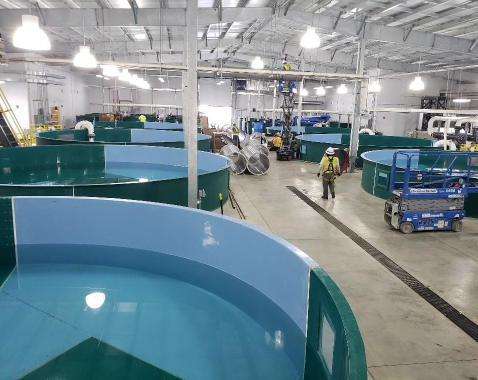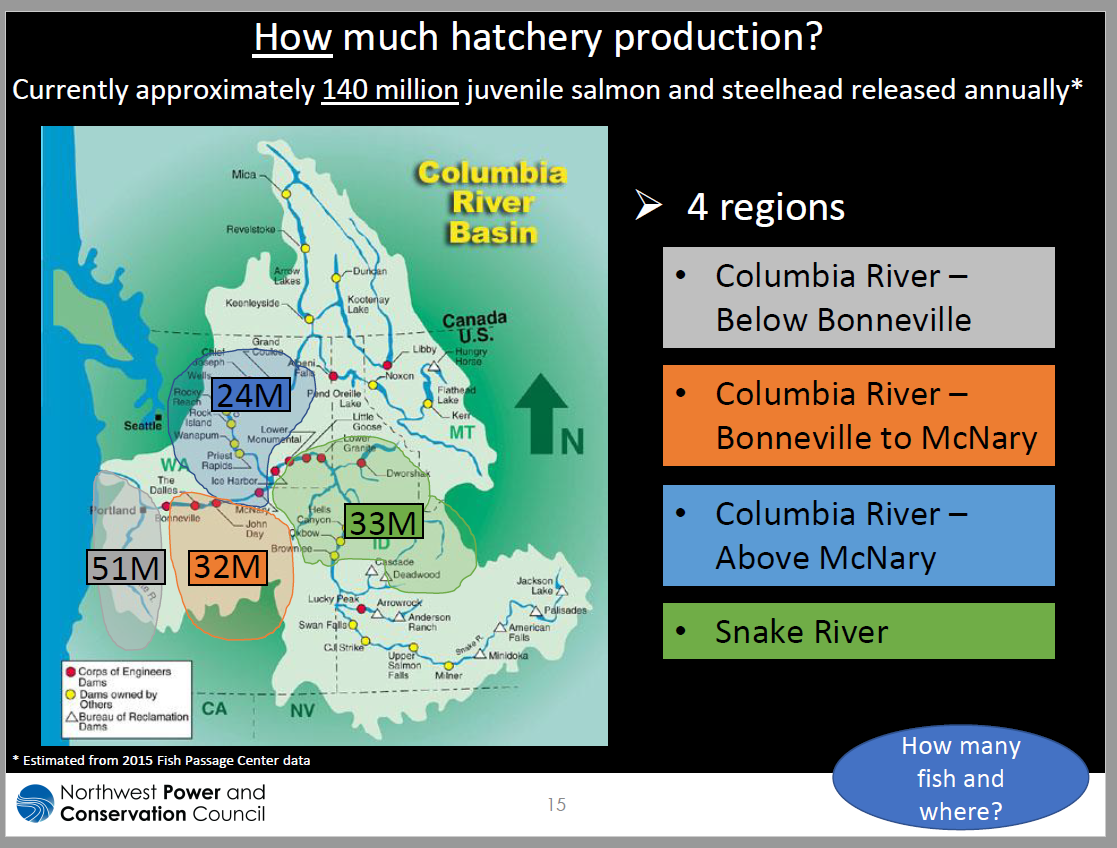Report: Most Hatchery Salmon and Steelhead Are Released Above Bonneville Dam
- March 11, 2021
- John Harrison

About 140 million ocean-going juvenile salmon and steelhead are released from fish hatcheries in the Columbia River Basin annually, and of these about 70 percent are released from facilities upstream of Bonneville Dam.
That’s a big shift from common practice before Congress passed the Northwest Power Act in 1980. Before the Act, which authorized the four Northwest states to create the Northwest Power and Conservation Council, salmon hatcheries downstream of Bonneville produced tens of millions of salmon annually, primarily for the benefit of commercial fisheries in the lower Columbia and the ocean. Production upstream from Bonneville was much lower.
Since the Power Act, hatchery production has shifted to help rebuild salmon and steelhead runs that were reduced due to impacts from the construction and operation of hydropower dams on the Columbia and its tributaries, in addition to impacts due to human development, such as water diversions, timber harvest, pollution, and other impacts. Approximately 12 percent of these upriver hatchery release programs are funded by the Bonneville Power Administration through the Council’s Columbia River Basin Fish and Wildlife Program, which mitigates the impact of hydropower dams. However, those aren’t the only hatchery programs, and Bonneville isn’t the only funder. In all, there are 155 separate juvenile-fish release programs co-managed by tribal, state and federal partners that are funded by several private or public utilities and federal agencies.
Understanding how many fish of which species are being released, from which facilities, and for what purposes is a challenge. But it is information worth knowing because it will help gauge the success of these programs and identify future needs for funding and infrastructure improvements.

Maureen Hess, Council staff Fish and Wildlife Program Analyst, reviewed Columbia River Basin salmon and steelhead hatchery production at the March meeting of the Council’s Fish and Wildlife Committee. Hess said the information in her presentation is part of an ongoing effort by state, federal, and tribal partners in the U.S. v. Oregon Management Agreement to summarize salmon and steelhead production to better understand funding needs for hatchery programs and facilities.
She said this coordinated approach to adequately fund hatchery operations and maintain and modernize hatchery infrastructure is critical to meeting obligations to mitigate the impacts to fish due to development in the basin and construction/operation of hydropower dams – a requirement placed on the Council and Bonneville by the Northwest Power Act. Other federal agencies and utilities that own and operate dams have similar responsibilities under different laws and regulations. It’s also critical knowledge to help improve understanding of whether production programs are meeting or not meeting mitigation objectives, and to identify current hatchery infrastructure issues and needs.
Funding for salmon and steelhead production in the Columbia River Basin above Bonneville Dam comes from a mixture of federal agency and private or public utilities. For example, approximately 78 percent of that production is federally funded – by Bonneville and other federal agencies. The rest is funded by public and private utilities that operate hydropower dams.
Here are some other take-aways from Hess’s presentation:
- There are 155 programs that release juvenile salmon and steelhead in the Columbia River Basin in regions above Bonneville Dam; about 80 percent of those releases serve the primary purpose of mitigating impacts caused by the construction and operation of hydroelectric dams
- These programs help mitigate the loss of 55 percent of the area and 31 percent of stream miles of spawning and rearing habitat that were blocked by dam construction in the Deschutes, Willamette, Snake, and Upper Columbia rivers
- Annually, of the roughly 97 million salmon and steelhead juveniles targeted for release in regions above Bonneville Dam, the Bonneville Power Administration funds production of about 56 percent of those fish, other federal agencies contribute about 22 percent, and public and private utilities also contribute about 22 percent.
- By species, 43 million of the roughly 97 million smolts targeted for release by all facilities each year above Bonneville Dam are fall Chinook, 26 million are spring Chinook, 11 million are steelhead, 9 million are coho, 5 million are summer Chinook, and 3 million are sockeye.
- While the Council’s fish and wildlife program’s artificial production programs include both anadromous (ocean-going) and resident fish throughout the basin, the component summarized in the presentation included only the approximately 12 million anadromous salmon and steelhead targeted for release from program-related facilities annually – approximately 3.5 million spring Chinook, 2.5 million fall Chinook, 2.5 million summer Chinook, 2 million Coho, 1 million Sockeye, and 200,000 Steelhead.
- Columbia River releases are small in comparison to releases elsewhere along the Pacific Rim – Alaska and Japan produce more than 1.5 billion smolts annually (mainly chum salmon in Japan, and pink and chum salmon in Alaska).
Information about Columbia River Basin hatcheries and fish production is available from a new interactive website on the Council’s homepage, www.nwcouncil.org. The website uses story maps and infographics to communicate the story of fish hatcheries and explains the various purposes of hatcheries for mitigation and conservation needs.



